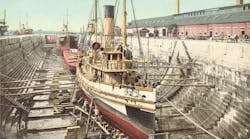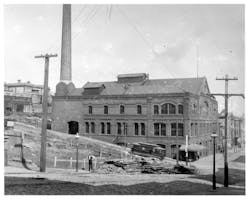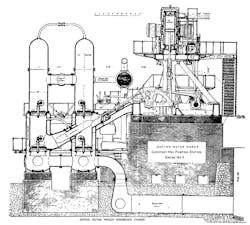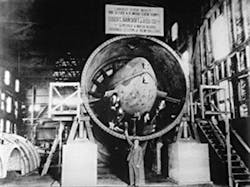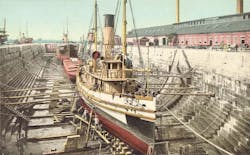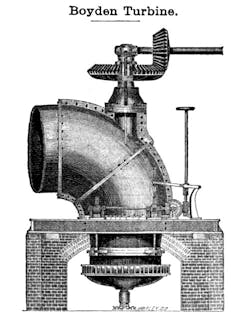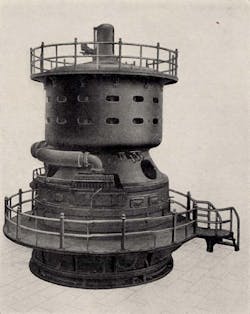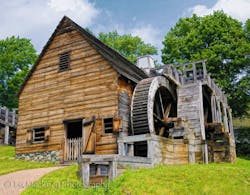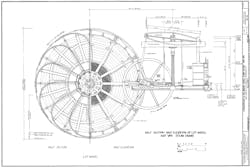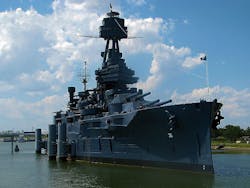The First 10 Mechanical Engineering Milestones from the ASME
Back in 1973, the American Society of Mechanical Engineers began honoring and recognizing landmarks in mechanical engineering. Here are the first 10 that earned that honor.
The Ferries & Cliff House Cable Railway
The cable cars of San Francisco are over 100 years old and an icon of the city. The system still in service includes much of the two original lines of the F&CH Cable Railway, as well as a power house and car barn designed and built by Howard Holmes, a civil engineer, oddly enough. The power house was originally steam-powered but was converted to electricity in the early part of the 20th century. The F&CH was one of the most complicated cable-car systems ever built to run from a single station and it took two years to build. Much of the original infrastructure is still in use, despite carrying 200% of the original capacity in terms of passengers and being almost 70 years past its originally expected lifetime.
Chestnut Hill Waterworks Engine No.3
When Boston needed more water for its growing population in 1894, it installed a pump designed by Erasmus Leavitt at Chestnut Hill Reservoir in Brighton, Mass. It used steam from a coal-fired furnace and at its normal speed, 50 rpm, it could pump 25 million gallons of water every 24 hours.
The pump is a triple-expansion, three-crank rocker engine with pistons 13.7 in., 24.375 in., and 39 in. in diameter, and a 6-ft. stroke. The pump generated 575.7 hp, turning 1,000,000 BTUs into 141,885,000 ft.-lb. The mechanism is estimated to be 89.5% efficient. It is still thought to be in working condition and is on display at the Boston Waterworks Museum.
New Orleans’ Wood Screw Pumps
Keeping New Orleans from flooding is a tough job. It’s surrounded by and below the Mississippi River, a major lake, and the ocean. This also makes rainwater and sewage an ongoing concern in the Crescent City. Plus, the city is often threatened by hurricanes coming off the Gulf of Mexico. In 1915, after a few years suffering with some difficult vertical shaft screws to drain canals and the city during floods, they installed thirteen 12-ft. diameter pumps designed by A. Baldwin Wood. When finished, each could pump 392 million gallons of water a day. When they were all operating, the water they moved in a day would fill a 10-ft.-square canal 1.5 miles long. Each pump was powered by a 600hp synchronous motor. The pumps are still the largest and most efficient low-lift pumps in the world and are still in service in New Orleans.
Kittery Shipyard
The Kittery Naval Shipyard in Maine has been home to shipbuilders since 1690, first the British, then the newly established Americans. The shipyard actually built ships used by the U.S. Navy to break free of Britain. The shipyard eventually expanded and practically became part of New Hampshire. Many inventions and structures for building ships originated in Kittery, going from sail to steam to diesel to nuclear power. It was also one of the first self-sufficient industrial sites, with everything from a foundry, forge, blacksmiths, woodworking, and rope making, and it even grew some its own food. It built the first submarine for the U.S. Navy and the first nuclear submarine. Today, it remains the only government shipyard dedicated to submarine engineering and has built over 130 subs for the Navy.
102-Inch Boyden Hydraulic Turbines
Two Boyden turbines built between 1871 and 1873 in Cohoes, N.Y., supplied 800 hp each to the Harmony Mill textile factory until 1915 when the mill converted to electric power, which came from a hydroelectric plant. The water turbines are the largest and nearly most powerful ever built in the U.S. and the oldest mill turbines still surviving. U.A. Boyden invented the new turbine (i.e., Boyden turbines) as a follow-on to the Fourneyron turbine. But he added a conical approach passage for incoming water, guide vanes in the outlet passages, a submerged diffuser, and a diverging exit passage that converted some of the discharging water’s kinetic energy into pressure, thereby increasing the effective head across the turbine. Power was taken from the turbines through bevel gearing and a common horizontal shaft. The shaft drove pulleys that transmitted power through belts to all five floors of the Harmony Mill.
Curtis Vertical Steam Turbine
When the Curtis steam-turbine generator was built in 1903, it was the most powerful in the world, creating 5,000 kW of electric power. It was invented by Charles Curtis, who came up with the two-stage, multi-speed impulse turbine that used velocity compounding impulses and “Curtis Staging” to make more effective use of the steam’s energy. But it took engineer William Le Roy Emmet to fix several design problems and make the turbine a success. The compact turbine, which was built and marketed by General Electric, stood 25-ft. tall, much shorter than the 60 ft. needed to house a reciprocating engine/generator of comparable output.
Saugus Ironworks
The first commercial and successful ironworks in North America was built in Saugus, Mass., between 1646 and 1647. The area had everything ironworkers needed: nearby sources of iron ore and limestone (used as flux), forests to turn into charcoal, and moving water to power bellows, hammers, and rollers. The plant initially could produce about 200 tons of iron a year. But the plant relied on nearby bog ore, which was exhausted by 1675, and the plant closed.
Pioneer Oil Refinery
The Pioneer Oil refinery in the Pico Canyon area of California was the first successful refinery in the western United States. It was built in 1876 by the California Star Oil Works, a predecessor to the Standard Oil Co. and could make kerosene, benzenes, an illuminating oil, and lubricants from the regions sulfurous and asphalatic crude oil. The plant’s two largest stills could produce 150 barrels per day of refined product.
Steam-Powered Water Wheel of C&D Canal
When the 14-mile Chesapeake and Delaware Canal was completed between the Chesapeake Bay and Delaware River in 1829, it became popular for moving goods between Baltimore and Philadelphia. There was one problem, though: during the dry months, there was never enough water around the high-point of the 66-ft.-wide canal. This limited traffic and cost the canal owners money. So they held a contest for the best design that could lift 200,000 ft.3 up a 16-ft. bank while consuming less than 560 lb/hr of coal.
The winner of that contest, Merrick & Sons, built a 39-ft. wheel made of iron and wood with 12 scoops. It was turned at 24 rpm by a condensing-beam steam engine with a 36-in. wide cylinder and a 7-ft. stroke. A second 150-hp engine was added the next year. The wheel then could deliver 170 tons of water per minute running up to 24 hours per day while it consumed eight tons of coal per day.
Reciprocating Marine Steam Engine, USS Texas
The USS Texas is the last surviving warship powered by reciprocating steam engines. After that, with exception of the USS New York, which has not survived, Navy ships began using steam turbines for propulsion. The Texas used a pair of four-cylinder, triple-expansion engines that could generate 14,000 hp and gave the twin-screwed ship a top speed of 21.05 knots when turning the 18.5-ft. diameter screws at 125 rpm. Lubricating oil was sent to the moving parts under about 50 psi of pressure. The ship served the Navy from 1912 through 1948 and is said to have fired the opening naval salvo on D-Day. It is now on display at the San Jacinto Battleground State Park in Texas.
